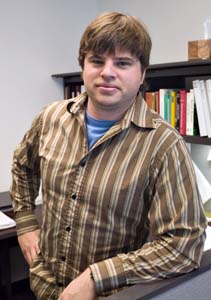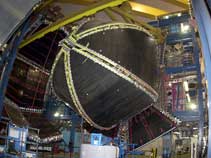2007 News Release
Nuclear Physicists Reach for the Stars

Mark Paris, a postdoctoral researcher, joined EBAC in October 2006.
"This research can change our understanding of the evolution of stars," says Harry Lee, Excited Baryon Analysis Center leader and joint Jefferson Lab and Argonne National Lab senior scientist. "So the research we're doing here has consequences, not only in nuclear physics, but also in astrophysics and other fields."
Established in January of 2006, EBAC (link: http://ebac-theory.jlab.org/main.htm) resides within the Lab's Theory Center. Its mission is to provide theoretical support to worldwide experiments probing the structure of excited baryons. Baryons, such as protons and neutrons, are building blocks of ordinary matter. However, the baryons inside stars are thought to be more than just protons and neutrons.
"In a star, the density and temperature could be very, very high, so the matter there has not only the regular protons and neutrons, but also their excited states, what we call the N-star (N*) states," Lee explains. To really understand our universe, he says, it's important to understand all the forms matter can take. "It's not enough to understand the protons and neutrons, you need to understand these excited states, too."
EBAC member Mark Paris likens the normal and excited states of a baryon to a vibrating telephone cord. "If you've ever been talking on the phone and you look at the cord, you notice that it moves up and down slowly and evenly. Let's say the swaying cord is a regular baryon. Now if you twang the cord, giving it more energy, you can get more wiggles or ripples in it, and that's like an excited baryon," he explains. Paris is a postdoctoral scientist and the first full-time EBAC researcher (link: http://ebac-theory.jlab.org/research.htm).
Principal EBAC Researchers
Bruno Julia-Diaz (University of Barcelona)
T.-S. Harry Lee (Jefferson Lab and Argonne National Laboratory)
Akihiko Matsuyama (Shizuoka University)
Mark Paris (Jefferson Lab)
Toru Sato (Osaka University)
Alexander Sibirtsev (Jefferson Lab, University of Bonn & FZ Juelich)
Other affiliated EBAC researchers can be found at: http://ebac-theory.jlab.org/people.htm
Facilities conducting N* research
Halls A, B and C at Jefferson Lab
MAMI at Mainz
GRAAL at Grenoble
LEGS at Brookhaven
LEPS at SPRing-8
ELSA at Bonn
To find out how the properties of excited baryons differ from their regular counterparts, scientists at Jefferson Lab and elsewhere are using accelerators to produce these particles. For instance, the N* program in Hall B aims to make excited baryons that have never before been seen.
"In a typical experiment, you have a photon or an electron coming in and hitting your target, such as a proton. The proton gets excited," Paris says. In the case of Jefferson Lab's CEBAF accelerator, the incoming electron 'twangs' the proton, giving it extra energy. Extra energy transforms the proton into an excited baryon. This excited baryon doesn't last very long, falling apart nearly instantaneously. The bits the particle split into are recorded in sensitive detectors. The data collected by these detectors can reveal how an excited baryon most likely will fall apart.
One goal of EBAC is to further develop and apply theories to existing data. These theories may help scientists squeeze more information about the properties of the excited baryon from the data, allowing experimentalists to get more information out of their data and to also design better future experiments from that information.
These new theories may serve as tools for eventually tackling one of the most difficult problems in nuclear physics. Physicists are working to link the description of matter's building blocks, gleaned from experiments, to the most fundamental theory yet for describing how these building blocks make up matter: quantum chromodynamics, or QCD.
"So we want to understand not only how the excited states are made, but also how QCD works to form these baryons," Lee says. If that can be established, the potential benefit is enormous. "Suddenly you understand how the matter in stars is made of baryons, and this is one of the crucial keys to understanding how stars evolve."
"There are so many things that we do not understand about the structure of baryons", says Anthony Thomas, Jefferson Lab's Chief Scientist. "States that we expect have not been seen yet, while still others are in the wrong place. Through EBAC, we have the opportunity to make a truly comprehensive analysis of the world's data, including the beautiful new results from JLab. This promises new insights into how QCD works."
EBAC is the first of the Department of Energy Topical Theory Centers, an initiative put forth in the 2002 Nuclear Science Advisory Committee Long-Range Plan. In addition to the six principal members of EBAC, two new Jefferson Lab-based members will come on board in the fall: Hiroyuki Kamano from Osaka University and Kazuo Tsushima from the University of Salamanca.
Jefferson Lab, based in Newport News, Va., is a basic physics research facility that studies the particles and forces that make up the nucleus of the atom. The Lab is managed and operated for the U.S. Department of Energy's Office of Science by Jefferson Science Associates, LLC.


